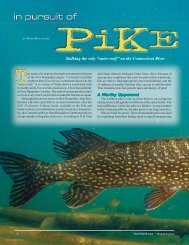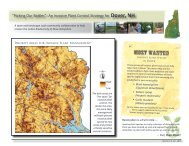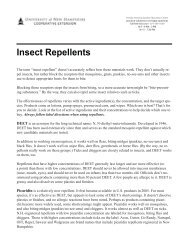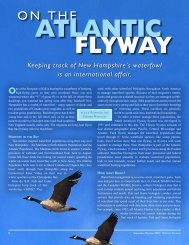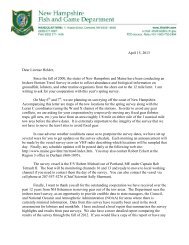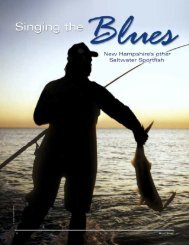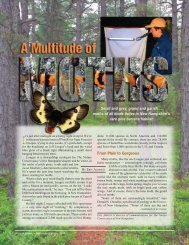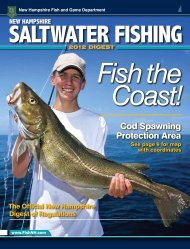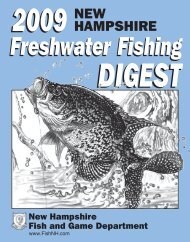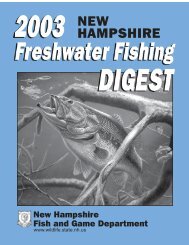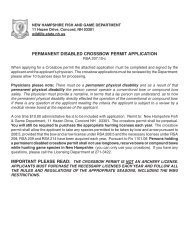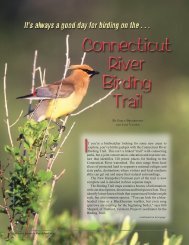1 STATE OF NEW HAMPSHIRE FISH AND GAME COMMISSION In ...
1 STATE OF NEW HAMPSHIRE FISH AND GAME COMMISSION In ...
1 STATE OF NEW HAMPSHIRE FISH AND GAME COMMISSION In ...
Create successful ePaper yourself
Turn your PDF publications into a flip-book with our unique Google optimized e-Paper software.
<strong>STATE</strong> <strong>OF</strong> <strong>NEW</strong> <strong>HAMPSHIRE</strong><br />
<strong>FISH</strong> <strong>AND</strong> <strong>GAME</strong> <strong>COMMISSION</strong><br />
<strong>In</strong> the Matter of<br />
License Revocation of Steven R. Laro<br />
DECISION ON THE MERITS<br />
This proceeding was commenced in response to a letter of request filed with the New Hampshire<br />
Fish and Game Department (Department) on or about December 23, 2004 on behalf of the family<br />
of Robert H. Proulx. The letter alleged that the respondent, Steven R. Laro (Mr. Laro or<br />
Respondent), carelessly discharged his firearm during a hunting drive on January 3, 2004 in<br />
Corbin Park, Croydon, New Hampshire, causing the death of his hunting companion, Robert H.<br />
Proulx. A New Hampshire Fish and Game Department (Department) investigation ensued and it<br />
was determined that there was probable cause to proceed to hearing.<br />
PROCEDURAL BACKGROUND.<br />
By letter dated February 3, 2005, Mr. Laro was noticed that a hearing would be held before the<br />
Fish and Game Commission (Commission) on March 16, 2005. He was asked to notify the<br />
Department no later then February 15, 2005 if he intended to appear at the hearing. He was<br />
further advised that, if he did not choose to appear, the Commission intended to consider the<br />
evidence that it received and might revoke his hunting license on that date.<br />
On March 4, 2005, by letter dated February 28, 2005, Attorney Paul Maggiotto notified the<br />
Department that he was representing Mr. Laro and requested a postponement of the hearing and<br />
requested a pre-hearing conference. The presiding officer granted Attorney Maggiotto’s requests.<br />
A Prehearing Conference was noticed and held on March 15, 2005. At the prehearing<br />
conference, the presiding officer heard arguments on pending motions. The parties and Attorney<br />
Craven agreed to a procedural schedule that was accordingly ordered by the presiding officer.<br />
The hearing on the merits was rescheduled for April 13, 2005. Mr. Laro agreed not to hunt in<br />
New Hampshire pending resolution of this matter.<br />
On March 29, 2005, the Commission granted a motion from Attorney Maggiotto for an extension<br />
of time for complying with the Prehearing Conference Order from March 29, 2005 to April 7,<br />
2005.<br />
The hearing on the merits of the matter was held on April 13 and 21, 2005, at Fish and Game<br />
headquarters, 11 Hazen Drive, Concord, New Hampshire 03301.<br />
As a preliminary matter at the hearing on the merits, the Commission granted Mrs. Proulx’s<br />
motion for limited intervention and addressed other pending pleadings as follows:<br />
1
Motion of the Department to Limit Adversary Procedures.<br />
The counsel for the Department filed the motion on March 15, 2005. Mr. Laro objected thereto<br />
on April 6, 2005. The Commission denied the Department’s motion. The Commission agrees<br />
with the Department that the due process rights of recreational licensees are less than those of<br />
professional and motor vehicle licensees but feels that live witnesses enable the Commission to<br />
better assess their respective credibility and ensure, perhaps to excess, an opportunity for the<br />
parties to have a full and fair opportunity to be heard and to cross-examine witnesses. See, e.g.,<br />
RSA 541-A:33, IV. We note with appreciation that both the respondent and the Department<br />
availed themselves of this opportunity fully yet efficiently and professionally.<br />
Application of the Department to Admit Certain Documents.<br />
The Department’s application, dated April 4, 2005, requested that the Commission admit or take<br />
official notice of documents relating to a prior judicial proceeding involving Mr. Laro entitled<br />
State v. Carl Laurie, 139 N.H. 325 (1995). The Department contends that those case documents<br />
relate to Mr. Laro’s credibility and character. The Respondent objected and proposed numerous<br />
new rebuttal exhibits should the application be granted. The Commission denied the application<br />
for lack of probative value. The events addressed in Laurie occurred more than a decade ago and<br />
do not necessarily relate to the merits of the case now at hand.<br />
Respondent’s Motion to Dismiss the Department’s Revocation Proceedings Under RSA<br />
214:18.<br />
The Respondent, by motion dated March 29, 2005, sought dismissal of the proceeding alleging<br />
that license revocations for causing death or injury to another person can be brought only<br />
pursuant to RSA 207:37-b, the first paragraph of which provides:<br />
207:37-b Hunting License Revoked.<br />
I. Any person, while on a hunting trip or in pursuit of wild animals<br />
or wild birds or while target practicing, who is convicted of shooting<br />
and wounding or killing a human being shall not be issued a license to<br />
hunt or, if the person holds a hunting license, the license shall be<br />
revoked and the person shall not be granted a license to hunt for the<br />
following period:<br />
(a) If the shooting and wounding of a human being results in death<br />
or serious bodily injury, as defined in RSA 625:11, VI, the license<br />
revocation shall be for a period of 10 years.<br />
(b) If the shooting and wounding of a human being results in less<br />
than serious bodily injury as defined in RSA 625:11, VI, the license<br />
revocation shall be for a period of 5 years.<br />
Mr. Laro appears to contend that the amendment of RSA 207:37-b in 1997 (to require revocation<br />
of a hunting license on conviction of a hunting related death or wounding of a human being)<br />
implicitly repealed RSA 214:18. He also argues that to the extent RSA 214:18 remains in force,<br />
2
it is invalid as an unconstitutionally vague and overly broad delegation of legislative power to<br />
the Department’s Executive Director. We agree with the arguments made by the Department in<br />
its objection to the motion. Repeal by implication is disfavored. State v. Perra, 127 N.H. 533,<br />
535 (1985)(Implied repeal must be rejected “if any reasonable construction of the statutes can<br />
avoid it”). The amendment to RSA 207:37-b requires revocation after conviction but does not,<br />
either expressly or implicitly, require a conviction in order to revoke a license. RSA 207:37-b<br />
does not purport to preclude suspension or revocation of a hunting license absent a conviction<br />
pursuant to other statutory provisions. Had the Legislature wanted to provide otherwise, it would<br />
have done so. Rather it amended RSA 207:37-b to provide for summary revocation where the<br />
fault rises to the level of criminal behavior. It left intact the agency’s other powers under, among<br />
other things, RSA 214:18 to sanction other irresponsible and dangerous acts by licensees. If<br />
there is a conviction, revocation is automatic pursuant to RSA 207:37-b. <strong>In</strong> the absence of a<br />
conviction, RSA 214:18 requires a pre-revocation hearing and a demonstration that the licensee’s<br />
actions make him or her “physically or mentally an improper or incompetent person to carry<br />
firearms, or is handling firearms improperly, or so as to endanger human life or property”.<br />
Each of the two statutes, especially when read in the context of the overall statutory scheme,<br />
addresses different circumstances and can be readily construed as being consistent. 1<br />
Regarding Mr. Laro’s assertion that RSA 214:18 is unconstitutional, the Commission presumes<br />
the constitutionality of its enabling statutes. Furthermore, in RSA 214:18, the Legislature clearly<br />
and expressly set forth the criteria here applied by the Commission 2 . Accordingly, we denied the<br />
motion to dismiss.<br />
FINDINGS <strong>AND</strong> CONCLUSIONS.<br />
On thorough review of, and only of, the entire record exhibits and testimony, and applying our<br />
experience, technical competence and specialized knowledge in evaluating the evidence, we<br />
make the following findings and conclusions 3 . The evidence is uncontroverted that:<br />
Mr. Laro holds a New Hampshire Resident Lifetime Hunting and Fishing Combination License<br />
purchased on January 4, 2001.<br />
Blue Mountain Forest Association is a private hunting preserve located in Croydon, Sullivan<br />
County, New Hampshire. The area is commonly referred to as Corbin Park after Austin Corbin<br />
who founded the Park in the late 1800’s. Use of the area is limited to members and their guests.<br />
There is no evidence that any person has ever been killed while hunting in the Park since its<br />
creation in 1888.<br />
1 It is noteworthy that the Legislature left intact RSA 207:39-a which requires up to a five year hunting license<br />
revocation for killing, injuring or damaging domestic fowl or animals while hunting. If the Respondent’s argument<br />
is accepted that a conviction is required for shooting humans, it would lead to the absurd result that the Legislature<br />
places a higher value on bird and animal life and welfare than on human life and welfare. See <strong>In</strong> re Russell C., 120<br />
N.H. 260, 264, (1980)(statute should not be interpreted to lead to an absurd, unjust, or illogical result).<br />
2 The portion of RSA 214:18 that the Respondent alleges is unconstitutional are the two references allowing the<br />
executive director to suspend or revoke a license “for any... cause that he may deem sufficient” This provision does<br />
not apply in this case. The Commission and Executive Director only applied the express criteria set forth by the<br />
legislature in RSA 214:18 in determining Mr. Laro’s qualifications for continued licensure.<br />
3 Pursuant to inter alia, RSA 541-A:33, VI and 541-A:31, VIII.<br />
3
Just before Christmas, 2003, Mr. Laro was invited to hunt in the Park as a guest of Mr. Roger<br />
Williams, a Corbin Park member.<br />
On or about 0700 hours on January 3, 2004, Mr. Laro met Robert Barr at the Weathervane<br />
Restaurant in Chichester, New Hampshire.<br />
Mr. Laro left his vehicle at that location and together they drove to Corbin Park where they met<br />
the other members of the hunting group, Angelo Cacciatore, Robert Proulx, John Twitchell and<br />
Roger Williams, at the main lodge at approximately 0830 hours.<br />
The six-member party was assigned to hunt a geographic area of Corbin Park designated as<br />
Section A. Deer, elk and boar were the species to be hunted.<br />
The group chose to employ a hunting tactic known as “driving”. Hunters engaged in this activity<br />
either walk through a hunting area with the intent of sighting and shooting and/or pushing game<br />
or remain stationary waiting for an opportunity to shoot game that has been pushed to their<br />
location ahead of the hunters who are moving through the woods. It was agreed that all members<br />
could shoot if they saw game.<br />
From the lodge the group traveled to their respective hunting locations.<br />
First, Angelo Cacciatore and Roger Williams, accompanied by the others, were transported by<br />
vehicle and dropped off at a point nearer to their hunt location. There Mr. Cacciatore and Mr.<br />
Williams boarded ATV’s at the drop off point and drove themselves into the area where they<br />
were to hunt. They would be sitting on the northern end of Section A, waiting for passing game<br />
and to be joined later by the remainder of the group.<br />
After dropping off Mr. Cacciatore and Mr. Williams, the remaining four members drove back to<br />
the Lodge, parked their truck and walked into the woods to their assigned starting points along a<br />
woods road. Mr. Twitchell, Mr. Proulx, Mr. Laro and Mr. Barr walked in a westerly direction<br />
and positioned themselves in this order along the woods roads.<br />
Each “pusher” was expected to wait until Mr. Barr was in position and advised them by two-way<br />
radio message that it was time to start walking toward the sitters; i.e. to begin the drive. It was<br />
agreed that the pushers would proceed in a northwesterly direction. Mr. Proulx did not have a<br />
compass but indicated he would start along the Red trail. Mr. Laro testified that he set his<br />
compass at a bearing that he believed would parallel Mr. Proulx’s path.<br />
Mr. Barr left Mr. Laro at Mr. Laro’s starting position and walked to his position. This was Mr.<br />
Laro’s first day hunt and he testified that on his previous overnight hunts the team would review<br />
maps and plan routes the night before. They did not do so for this trip. Mr. Laro had been<br />
directed to walk uphill toward the sitters’ location. Mr. Laro followed his pre-set compass<br />
course of 310° that he believed would parallel Mr. Proulx’s path and lead him to the sitters’<br />
position. He observed a field through which he would travel when he started his hunt. He<br />
waited for the signal to start the hunt. He reported that he did not believe that there would be<br />
4
game in the field; that he was not prepared to shoot a boar; that his rifle was not ready and that<br />
his ability to operate his rifle was restricted by the gloves he was wearing.<br />
Mr. Barr radioed that it was time to start.<br />
Mr. Laro proceeded toward the field. Minutes into the hunt Mr. Laro heard a noise and believed<br />
he saw a boar. Mr. Laro unshouldered his rifle. Mr. Laro brought his rifle into shooting position<br />
but was unable to fire because he had not released the safety that prevents an accidental<br />
discharge. Mr. Laro looked at the safety and released it. Mr. Laro looked back through the<br />
scope. Mr. Laro saw motion. Mr. Laro shot one shot. Mr. Laro’s rifle lifted from the recoil.<br />
Mr. Laro repositioned his rifle. Mr. Laro saw what he believed was the hind end of a running<br />
boar. Mr. Laro shot a second time. Mr. Laro looked through the scope to prepare for a third<br />
shot. Mr. Laro saw nothing - “there is no movement”.<br />
Mr. Laro believed he had shot a boar and, when asked, advised other members over the radio that<br />
he had shot a boar.<br />
Mr. Laro then tried to find the boar but instead discovered Mr. Proulx’s lifeless body. Mr.<br />
Proulx died instantly of his wound and, although Mr. Laro argued that Mr. Proulx may have<br />
staggered or rolled away from where he was shot, there was no evidence contradicting that his<br />
body was found at the site where he was shot 4 .<br />
Mr. Laro radioed that he had shot Mr. Proulx and attempted to run for help. Mr. Barr responded<br />
to the scene and discovered Mr. Laro incoherently calling for help for Mr. Proulx. Mr. Laro<br />
stated that Mr. Proulx was dead.<br />
Mr. Twitchell first, then Mr. Barr, ran back to the Lodge to summons help.<br />
State Police and the Department were notified at approximately 1000 hours that a fatal hunting<br />
related shooting had occurred at Corbin Park.<br />
The Department conducted an investigation of the shooting.<br />
The investigation revealed that, at the time of the shooting, an early morning rain had stopped<br />
and the sky was cloudy and overcast. The ground was snow covered and visibility was good.<br />
Mr. Laro had shot twice and one of the rounds had struck Mr. Proulx in the back killing him. The<br />
area between Mr. Laro and Mr. Proulx consisted of open softwoods and fields. Mr. Laro’s rifle<br />
was equipped with a variable power scope set on 5x magnification. The rifle and scope were in<br />
working order. The distance between Mr. Laro and Mr. Proulx at the time of the shooting was<br />
approximately 72 yards. Through the scope, the distance would appear to be approximately 42<br />
feet. The scope would provide a field of view of 16 feet; with eight feet either side of a target<br />
4 There were no trail of blood, roll marks or footprints supporting Mr. Laro’s argument and the slope of the terrain<br />
was inconsistent with Mr. Proulx having rolled significantly. Also, Officer Suttermeir testified that the location of<br />
the shell casings was consistent with firing each of the two shots in the same general direction rather than swinging<br />
the barrel substantially between shots at a moving target. Accordingly, it is reasonable for us to conclude that Mr.<br />
Laro’s line of fire was in the general direction of where Mr. Proulx’s body was found.<br />
5
centered in the image. No evidence that a boar was present in the immediate vicinity of Mr.<br />
Proulx at the time of the shooting was observed.<br />
The investigator’s report indicated that there were no fresh boar tracks in the area between Mr.<br />
Laro and Mr. Proulx and that the only boar tracks in the area at issue were from a time period<br />
well before the hunting party arrived in the Park and showed no indication of a boar spooked by<br />
human proximity or by gunfire. It was concluded that what Mr. Laro thought was a boar was in<br />
reality Mr. Proulx.<br />
<strong>In</strong> considering Mr. Laro’s involvement in this matter, the Commission and Executive Director<br />
have concluded that Mr. Laro was handling a firearm improperly and, as a result, he caused the<br />
death of Mr. Robert Proulx.<br />
Mr. Laro was charged by the Sullivan County Attorney with negligent homicide and felonious<br />
use of a firearm. A Sullivan County Superior Court Jury acquitted him of both charges on<br />
December 13, 2004.<br />
By letter dated December 23, 2004 to the Department’s Executive Director, Lee E. Perry,<br />
Attorney Jason M. Craven requested on behalf of Mr. Proulx’s family that the Department<br />
consider suspension or revocation of Mr. Laro’s hunting license pursuant to RSA 214:18. The<br />
Department reviewed the matter and determined that there were grounds to conduct a hearing on<br />
this matter. ANALYSIS <strong>AND</strong> CONCLUSIONS.<br />
Following the conclusion of the hearing on the merits, the Commission and Executive Director<br />
deliberated in public on the matter.<br />
<strong>In</strong> considering Mr. Laro’s involvement in this matter, the Commission and Executive Director<br />
concluded that Mr. Laro did not handle a firearm properly and as a result caused the death of Mr.<br />
Robert Proulx.<br />
The Commission voted unanimously to revoke Mr. Laro’s license. The Executive Director<br />
concurred.<br />
Hunters are not alone in the fields and forests of New Hampshire. With increasing land<br />
development and the growing presence of people engaged in non-hunting activities, there is a<br />
high probability that hunters will encounter non-hunters, as well as other hunters, while in the<br />
field.<br />
Mr. Laro suggested that Mr. Proulx contributed to the accident by not wearing “hunter orange”.<br />
Although the Commission agrees that wearing hunter orange during a hunt is recommended<br />
practice, the fact that Mr. Proulx was not wearing hunter orange does not excuse Mr. Laro. Mr.<br />
Laro knew that Mr. Proulx was wearing camouflage and that Mr. Proulx did not have a compass.<br />
More importantly, Mr. Laro knew that wearing hunter orange is not legally required in New<br />
Hampshire and should have known that it is not reasonable or safe to assume that the absence of<br />
color makes it safe to shoot. While hunting, a hunter should not shoot without being one<br />
hundred percent certain that the target is a wild animal. While hunter orange assists greatly in<br />
6
making this determination, it does not substitute for proper and safe hunting practices. A safe<br />
hunter should never base identification on sound alone or as in this case, sound in combination<br />
with what appears to be the hind end of a boar 5 .<br />
While Mr. Laro professes a belief that he was aiming at a running boar and not a human being<br />
when he killed Mr. Proulx, there is no evidence to support his assertion that there was a boar in<br />
close proximity to Mr. Proulx when he shot. Unfortunately, the fact that he shot and killed Mr.<br />
Proulx proves that his belief was incorrect and that he did not take the necessary precautions of<br />
being prepared to hunt and positively identify his target before firing.<br />
The testimony of Conservation Officer Sergeant Suttmeier and Assistant Director Lynch<br />
conforms to what is taught in this state’s hunter safety programs and literature. The proximity of<br />
other people in the hunting area must be fully considered before deciding to pull the trigger. A<br />
competent hunter adhering to proper hunting and gun handling protocols would assume that<br />
every living creature is a human being until proven differently. A safe hunter realizes how easy<br />
it is to mistake a person for game and would not shoot until there is a clear and unobstructed<br />
view of the intended target. Mr. Laro should have known that he was aiming at a human being<br />
and his failure to discern the difference causes us to question his ability to insure that he could<br />
avoid another catastrophe in like circumstances.<br />
The fact is that Mr. Laro did not need to kill every animal that he saw as this was a sport hunt,<br />
not a self defense situation 6 . No wild animal is worth the life of a human being. Every hunter<br />
must be responsible to only take a shot when they are ready, have positively identified their<br />
target and background and are sure that their shot placement on the animal will hit a vital area on<br />
the animal. Mr. Laro had the choice to pass on what he thought was a boar, as he stated, “I<br />
wasn’t even prepared to hunt”. If indeed it had been a boar, he could have radioed ahead to the<br />
others that there was a boar headed their way.<br />
This was the last hunt of the season and there was much game around. Mr. Laro was anticipating<br />
the killing of many animals and this led to the poor shot choice and misidentification of his<br />
target.<br />
<strong>In</strong> lieu of presenting testimony before the Commission and Executive Director, Mr. Laro chose<br />
to play a tape recording of an interview conducted by State Trooper Jason Alstrom and<br />
Conservation Officer Sergeant Brian Suttmeier on January 7, 2005. Mr. Laro left the hearing<br />
during the time that the tape was played.<br />
Subsequently Mr. Laro was questioned regarding various details about his background and his<br />
behavior during the hunt. When Mr. Laro was asked to draw on paper the route taken by the<br />
boar he claims to have shot towards, he claimed that he could not do that since he had forgotten<br />
all about it. Mr. Laro was also asked what he meant by "not being ready to hunt" and was also<br />
5 <strong>In</strong> this case, Mr. Proulx was in a depression so Mr. Laro likely could only see his back from the waist up. During<br />
the hearing on the merits, we observed Mr. Proulx’s camouflage jacket and hat placed next to the mounted boar and<br />
observed that unless proper caution is exercised the jacket and hat could be mistaken for the rear of a boar.<br />
6 <strong>In</strong>terestingly, Mr. Laro testified that his firearms instructor training did not include checking the background before<br />
shooting because his training was as a combat instructor, not as a range officer, and he was trained to shoot quickly<br />
and efficiently in combat situations.<br />
7
not able to offer a satisfactory explanation. The same is also true of Mr. Laro’s responses to<br />
Commission queries regarding where on a boar Mr. Laro would aim his rifle to assure a merciful<br />
immediate killing shot. It was only after moving the wild boar mount at the hearing to a position<br />
in front of Mr. Laro that he reluctantly pointed to the position behind the boar's left shoulder as<br />
the best place to shoot a boar. Mr. Laro would not cooperate by standing next to the mounted<br />
boar and moving the mount as requested so that the Commission could see the boar's direction<br />
relative to Mr. Laro's shooting location. Mr. Laro’s behavior, responses and demeanor during his<br />
testimony, diminishes the credibility of the mitigating theories and explanations offered by his<br />
attorney. Mr. Laro’s credibility was further affected by his not being present during the tape<br />
presentation so that the Commission could observe his reactions to the taped testimony, by his<br />
explanation of why he left his scope on 5 power rather than increasing the field of vision, by his<br />
not recalling what was in his crosshairs when he fired and by professing ignorance to questions<br />
(such as the alleged boar’s location and direction when shots were fired) that he alone could<br />
answer as the sole living eye witness.<br />
<strong>In</strong> his opening statement Attorney Paul Maggiotto stated that this shooting represented a “cluster<br />
screw up of great proportions”. During his testimony Mr. Laro was asked, “why did it happen?”<br />
and “how could it be avoided in the future?” . Mr. Laro stated, “I don’t know what could have<br />
been done differently 7 .” Such a response is not indicative of someone who has acknowledged<br />
fault and learned how to avoid the same tragedy in the future. He knew or should have known<br />
that a drive is an inherently dangerous hunting technique, especially where all involved,<br />
including the sitters, were allowed to shoot, potentially shooting towards each other. Mr. Laro’s<br />
compass setting was NNW instead of the NW direction the party discussed, potentially leading<br />
him closer to others in the party. He knew he was not ready to hunt. He knew Mr. Proulx was<br />
without a compass and thus could have wandered off track. He knew Mr. Proulx was starting off<br />
on a worn trail, perhaps conducive to faster travel. He knew or should have known there could<br />
have been other persons in the Park. He knew he was not ready to hunt (e.g. says he was not set<br />
up, his rifle was shouldered, his scope not adjusted, his safety on, his hands in gloves that<br />
restricted operation of his rifle). He knew Mr. Proulx was wearing a camouflage jacket and hat,<br />
making it easier to mistake him for a boar. He should have known that under these<br />
circumstances he should have waited until he was ready to hunt and he should have been certain<br />
that he had head to tail identification of his target. Otherwise he should have let the presumed<br />
game go and perhaps radioed to the others that a boar might be headed their way. His failure to<br />
do this led to the first fatality in Corbin Park history, spanning over a century.<br />
Based on the testimony and materials in evidence at the hearing, including without limitation that<br />
cited above, we conclude that Mr. Laro did not act properly when he shot Mr. Proulx, nor has he<br />
demonstrated that he has acquired the necessary qualities or skills since the shooting to assure<br />
that he can properly handle firearms so as not to further endanger human life or property.<br />
SANCTIONS<br />
7 He also seemed to be placing blame on Mr. Proulx for not wearing orange and for allegedly not being where he<br />
was supposed to be, and did not assume any of the responsibility himself. Our review of the evidence indicates that<br />
Mr. Proulx is where he would be expected to be if he followed the trail he started out on.<br />
8
<strong>In</strong> addition to its recreational benefit of hunting to an individual hunter, the General Court finds<br />
“that it is in the best interest of the state and its citizens that the fish and game department<br />
promote our special heritage of hunting”. RSA 207:58.<br />
It is important that the Department endeavor to keep hunting as safe as possible and maintain the<br />
public’s favorable perception and acceptance of hunting. RSA 214:23-a and RSA 214:23-b<br />
establish educational requirements for hunters and a program to certify people in the safe and<br />
responsible handling of firearms while hunting.<br />
Various laws are in effect that allow hunting privileges to be denied, suspended or revoked in<br />
order to keep hunting safe. <strong>In</strong> addition to RSA214:18, RSA 214:18-b prohibits any person<br />
whose hunting privileges are under suspension or revocation in another jurisdiction from<br />
purchasing a license in New Hampshire; RSA 214:17 states that no license shall be issued to a<br />
person who is not suitable to carry a firearm; RSA 207:39-a states that any hunter who causes<br />
death or injury to domestic animals, ducks or fowl shall be liable to the owner for damages and<br />
shall have his license revoked and is not eligible to obtain a license for up to five years; and RSA<br />
207:37-b provides that the license of any person who is convicted of shooting or wounding<br />
which results in death or serious bodily injury shall be revoked for 10 years; or which results in<br />
less then serious bodily injury shall be revoked for 5 years.<br />
Our decision is made with these responsibilities in mind and after considering and evaluating the<br />
testimony and evidence using our collective experience and knowledge relative to firearms,<br />
hunting practices and wildlife conservation.<br />
It is ordered by the Commission and the Department’s Executive Director on this 27 th day of<br />
April, 2005 that Mr. Laro’s license to hunt in the State of New Hampshire be revoked for a<br />
period of ten years effective March 29, 2005 (the date that Mr. Laro voluntarily agreed not to<br />
hunt in New Hampshire); and that Mr. Laro may apply for a license at any time following the<br />
full revocation period and completion of a hunter education program; and a hunting license may<br />
be granted or restored following a hearing before the Executive Director and Commission at that<br />
time.<br />
9
____________________________________<br />
Theodore A. Tichy, Chairman, Coos County<br />
and Presiding Officer<br />
___________________________<br />
Walter Morse, Vice Chairman<br />
Hillsborough County<br />
________________________<br />
Sharon Guaraldi, Secretary/Treasurer<br />
Grafton County<br />
_____________________________<br />
Donald Clarke<br />
Sullivan County<br />
__________________________<br />
Robert Phillipson<br />
Cheshire County<br />
____________________________<br />
William Carney<br />
Merrimack County<br />
______________________<br />
Patricia Costa<br />
Belknap County<br />
_______________________<br />
Glenn Normandeau<br />
Coastal<br />
______________________<br />
Ellis Hatch<br />
Strafford County<br />
______________________<br />
Stephen Nottonson<br />
Rockingham County<br />
______________________<br />
Nelson Russell<br />
Carroll County<br />
______________________<br />
Lee E. Perry<br />
Executive Director<br />
10



